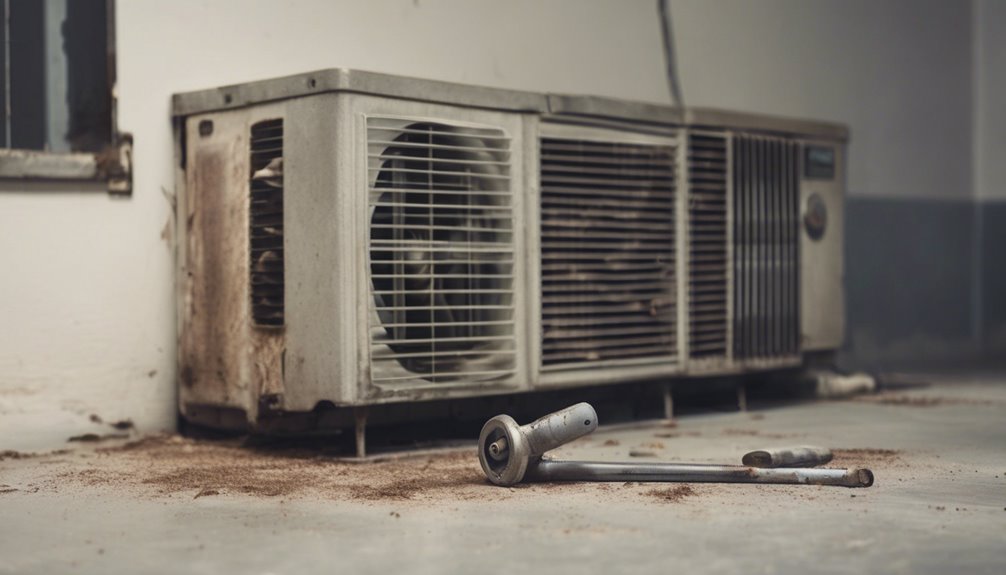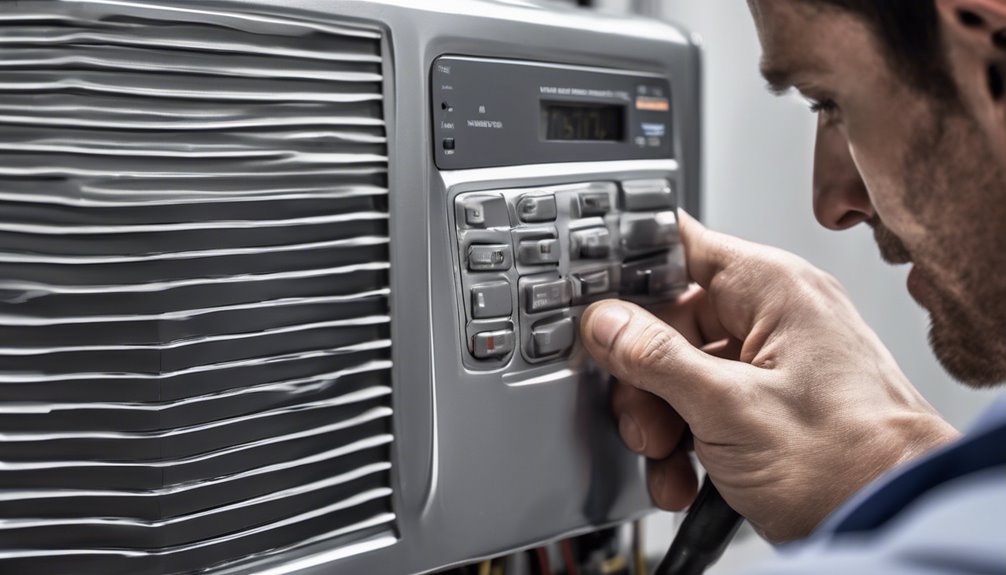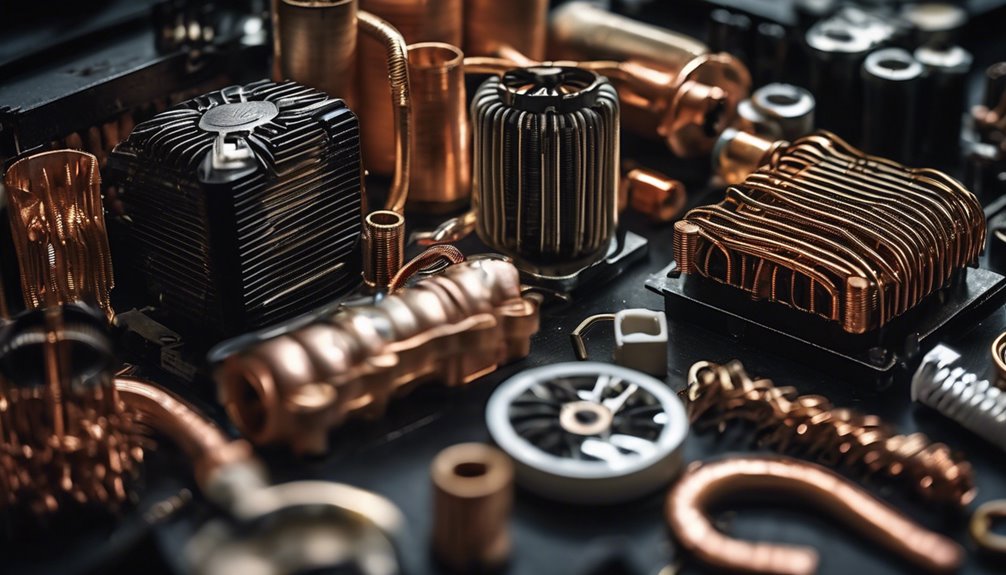If your air conditioner's fan is running slow, don't sweat it just yet! You can troubleshoot the issue yourself. First, check the power cord for damage and ensure it's properly plugged in. Next, inspect and clean the fan blades to improve airflow. Lubricate the fan motor to reduce friction. Verify that air can flow freely around the AC unit and adjust your thermostat settings to optimize fan performance. If these quick fixes don't work, there might be a more underlying issue – and that's where things get interesting.
Key Takeaways
- Inspect and replace worn or damaged mechanical components, such as bearings and belts, to improve fan speed and efficiency.
- Check the power cord and outlet for damage or issues, and ensure a secure connection to prevent electrical problems.
- Clean or replace dirty air filters and ensure unobstructed airflow to reduce strain on the AC fan and improve performance.
- Adjust thermostat settings to optimize fan speed and prevent overworking, and consider upgrading to a more efficient fan motor.
- Regularly inspect and maintain the fan blades, motor, and capacitor to prevent wear and tear, and reduce the need for repairs.
Identify the Source of the Problem
When your AC fan is running slow, it's essential to pinpoint the root cause of the issue before attempting any repairs.
You don't want to waste time and money on a fix that won't solve the problem. Start by inspecting the fan's mechanical components.
Check if the bearings are faulty or worn out, causing the fan to slow down. Also, examine the belts that drive the fan motor. Worn belts can slip or break, reducing the fan's speed.
If you find any issues with these components, replace them with new ones. This will ensure that your AC fan runs smoothly and efficiently once again.
Check the Power Source and Cord
You'll want to start by checking the power cord for any signs of damage or wear, as a faulty cord can slow down your AC fan.
Make sure it's properly plugged into the outlet, and that there aren't any obstructions or kinks in the cord that could be restricting power flow.
A simple check of the cord condition and plug can go a long way in resolving the issue.
Cord Condition Matters
A slow-running AC fan can be frustrating, especially during hot summer days.
When you're trying to stay cool, the last thing you want is a fan that's barely blowing air.
One common culprit behind this issue is the cord condition. Take a closer look at your AC fan's power cord.
Check for any signs of cord wear or cord damage, such as frays, cuts, or exposed wires.
If you notice any damage, it's likely preventing your fan from getting the power it needs to run at full speed.
Try replacing the cord to see if that solves the problem.
A new cord can make a big difference in your fan's performance.
Plug It Properly
Check that your AC fan is properly plugged into a working outlet.
A faulty outlet can cause your fan to run slowly or not at all. Make sure the outlet is functioning correctly by plugging in another device to test it.
If the outlet is working, inspect the power cord for any signs of damage or wear. A loose connection between the cord and the outlet can also slow down your fan.
Ensure the plug is securely inserted into the outlet and that there are no exposed wires. If you find any issues, replace the cord or have it repaired by a professional.
Inspect and Clean the Fan Blades
You'll want to take a closer look at the fan blades, as dusty blades can significantly slow down your AC fan's performance.
Check for any visible buildup of dirt, dust, or debris that might be weighing them down. By removing this grime, you'll be able to get your fan blades spinning smoothly again.
Dusty Fan Blades
Dusty fan blades are a common culprit behind a slow-running AC fan.
You can easily identify dusty fan blades by inspecting them closely. If you notice a thick layer of dust or dirt, it's time to clean them.
To do so, turn off the power to the AC unit and gently pull out the fan blades.
Use a soft-bristled brush or a cloth to wipe away the dirt and dust. You can also use a vacuum cleaner with a gentle suction setting to remove loose particles.
- Make sure to clean both sides of the fan blades
- Use a mild detergent and water if the blades are heavily soiled
- Avoid using harsh chemicals or abrasive materials that can damage the blades
- Dry the blades thoroughly before reinstalling them
- Regular fan cleaning will improve air circulation and reduce the strain on your AC unit
Remove Debris Buildup
Every few months, debris like pet hair, cobwebs, and dirt tend to accumulate on the fan blades, weighing them down and slowing the fan's rotation.
This debris accumulation creates air obstruction, reducing airflow and making your AC fan work harder.
To fix this, you'll need to inspect and clean the fan blades.
Turn off the power to the AC unit and remove the grille or cover to access the fan.
Use a soft-bristled brush or a vacuum cleaner to gently remove the debris from the blades.
Make sure to clean the entire surface, including the edges and corners.
Lubricate the Fan Motor
The fan motor in your air conditioner relies on proper lubrication to run smoothly and efficiently.
Without it, the motor bearings can overheat, causing the fan to slow down. To lubricate the fan motor, you'll need to choose the right type of oil.
Consider the oil viscosity, as it affects the motor's performance.
- Check your AC's manual to find the recommended oil type and viscosity
- Purchase the specified oil from a hardware store or online retailer
- Locate the lubrication points on the fan motor, usually marked with an oil can symbol
- Apply a few drops of oil to each point, following the manufacturer's instructions
- Run the AC for a few minutes to circulate the oil and test the fan's speed
Verify Proper Airflow
You'll want to ensure your AC fan is getting the airflow it needs to run efficiently.
Start by checking the condition of your air filter – a dirty or clogged filter can significantly slow down your fan.
Also, make sure there's a clear air path around the fan, free from any obstructions that could be impeding airflow.
Check Air Filter Condition
Clogged air filters are a common culprit behind slow-running AC fans.
You might be surprised at how often a simple filter cleaning or replacement can get your fan running smoothly again.
- Check your filter every 1-2 months, depending on usage and manufacturer's instructions.
- Look for visible signs of dirt, dust, or mold accumulation.
- Gently vacuum or tap the filter to remove loose debris.
- If the filter is damaged or extremely dirty, consider replacing it with a new one.
- Make sure to follow the manufacturer's guidelines for filter maintenance to ensure optimal airflow.
Ensure Clear Air Path
Now that you've checked and potentially cleaned or replaced your air filter, it's time to verify that air can flow freely through your AC unit.
Check your air vents to ensure they're not blocked by furniture, curtains, or other obstructions. Make sure they're open and unobstructed, allowing air to flow in and out of your AC unit.
Look for any signs of air obstruction, such as dust buildup or debris accumulation, and clean them out if necessary. A clear air path is crucial for your AC fan to run efficiently.
If you find any blockages, remove them to allow air to flow freely. This simple step can make a big difference in your AC fan's performance.
Check for Ice or Frost Buildup
Ice or frost buildup can silently sabotage your AC fan's performance, causing it to run slow and inefficiently.
Frosty buildup can quietly cripple your AC fan's efficiency, causing sluggish performance and wasted energy.
You'll want to check for any signs of frost accumulation or ice formation on the coils, fan blades, or other components.
- Check the evaporator coils for frost or ice buildup, which can restrict airflow and reduce fan performance.
- Inspect the fan blades for ice formation, which can cause imbalance and slow rotation.
- Look for signs of water leakage or condensation around the AC unit, which can lead to frost buildup.
- Check the air filter for blockages or moisture, which can contribute to ice formation.
- Consider running a defrost cycle on your AC unit to clear any existing ice or frost buildup.
Inspect the Fan Motor and Capacitor
Your AC fan's slow performance could also be attributed to issues with the fan motor and capacitor.
Start by inspecting the motor bearings for any signs of wear or damage. If you notice any rust, corrosion, or excessive noise, it's likely the bearings need replacement.
Next, check the electrical connections between the motor and capacitor for any signs of wear, corrosion, or loose connections. Tighten any loose connections and clean any corrosion you find.
If the capacitor is faulty, replace it with a new one of the same specifications. Remember to follow proper safety precautions when working with electrical components.
Balance the Fan Blades
As you continue to troubleshoot your slow-running AC fan, it's essential to ensure the fan blades are properly balanced.
Unbalanced blades can cause vibration, noise, and reduced airflow, making your fan run slower.
To balance the fan blades, you'll need to perform dynamic balancing, which involves adjusting the weight of each blade to achieve optimal spin optimization.
- Check for bent or warped blades and replace them if necessary
- Inspect the blades for dirt, dust, or debris and clean them thoroughly
- Use a balancing kit or consult a professional if you're unsure about the process
- Make sure all blades are securely attached to the fan hub
- Test the fan after balancing to ensure it's running smoothly and quietly
Check the Thermostat Settings
The thermostat settings could be the culprit behind your slow-running AC fan.
During the summer, you likely have your thermostat set to cool your home to a lower temperature. However, if you've set it too low, your AC fan might be working harder than necessary, leading to slow performance.
Check your thermostat settings to ensure you're not overworking your AC. Try switching to Auto mode, which allows the thermostat to regulate the fan speed based on the temperature. This can help your AC fan run more efficiently and at a normal speed.
Make sure you're not overriding the Auto mode with manual settings, as this can negate its benefits.
Consider Upgrading the Fan Motor
Over time, the fan motor in your air conditioning unit can wear out, leading to slow performance.
If you've checked the thermostat settings and cleaned the fan, but it's still running slow, it might be time to consider upgrading the fan motor. This can significantly improve motor efficiency and fan performance.
Some benefits of upgrading the fan motor include:
- Increased airflow and cooling capacity
- Reduced energy consumption and lower electricity bills
- Quieter operation and reduced noise levels
- Increased motor lifespan and reduced maintenance costs
- Improved overall air conditioner performance and reliability
Frequently Asked Questions
Can I Fix a Slow Running AC Fan on My Own?
You can try fixing a slow running AC fan on your own, but be cautious; if the issue is a faulty capacitor or worn bearings, it's best to seek professional help to avoid further damage or electrical shock risks.
Will Cleaning the Fan Blades Really Make a Difference?
You're wondering if cleaning the fan blades will really make a difference. Yes, it can! Dust accumulation on the blades causes airflow restriction, reducing fan speed. By cleaning them, you'll remove the obstruction and improve airflow, getting your fan running smoothly again.
How Often Should I Lubricate the Fan Motor?
You should create a lubrication schedule to keep your motor bearings running smoothly. Typically, you'll want to lubricate every 3-6 months, but check your fan's manual for specific guidance, as over-lubrication can be just as harmful as under-lubrication.
Can a Slow Fan Cause My AC to Freeze Up?
You're wondering if a slow fan can cause your AC to freeze up, and the answer is yes! A slow fan reduces airflow, leading to frozen coils, which can cause your AC to malfunction, and even worse, freeze up completely due to airflow restriction.
Will a New Thermostat Fix a Slow Running AC Fan?
You're wondering if a new thermostat will fix the slow fan issue. However, it might not be the culprit. Check if the thermostat calibration is off or if it was installed faulty, as these issues can cause problems, but a new one might not solve the fan issue.
Conclusion
You've finally fixed that slow running AC fan! By identifying the source of the problem, checking the power source, cleaning the fan blades, lubricating the motor, and verifying airflow, you've got your fan running smoothly again. If you're still having issues, upgrading the fan motor might be the ticket. Now, enjoy the cool breeze and the peace of mind that comes with a well-functioning AC unit.



